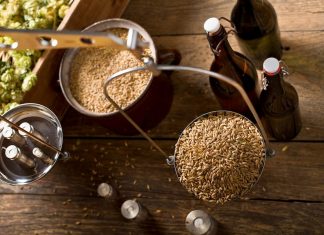
The beautiful, golden-looking drink you think of when you have a family gathering or are enjoying a nice dinner by yourself, has existed (in some form) for over 7,000 years. Although the flavours of white wine today are vastly improved and different, for many people, wine has been and still is the king of alcoholic drinks. It just has it all, the colour, the flavours, the aroma and the health benefits. So, let’s look into one of the most enticing flavours out there: chardonnay.
Chardonnay Wine Origin and Characteristics

Chardonnay is a green-skinned grape variety used in the production of white wine. The Burgundy wine region in France is where this variety, now spread all over the world, originated. Chardonnay accounts for almost 60% of Burgundy’s wine production compared to for example Pinot noir’s 30%. The remaining 10% is split among Aligoté, Cremant de Borgogne, and Rosé. This popular and very distinct grape is characterised by its bright acidity therefore lean, crispy flavours when grown in cooler climates, and sweeter, fruitier notes when grown under warmer weather conditions.
The Spectrum of Chardonney Flavours

Chardonnay is known as a winemaker’s favourite because it can grow under many climates and it’s easily workable in the cellar. Chardonnay wines produced in cooler climates carries notes of fresh fruit such as apple, pear, lemon, and spicy ginger flavour. Fresher, fruitier chardonnay is delicious by itself or when paired with soft cheeses, seafood, (fried) chicken, fatty potato chips or Asian food.
On the other hand, chardonnay grown in warmer climates is a dry, medium- to full-bodied wine with moderate acidity and alcohol. Its flavours range from apple to papaya and pineapple. It is worth noting that if you buy chardonnay wine aged with oak, you’ll taste notes of vanilla with a creamier texture which is many people’s favourite. Food pairing wise, dry chardonnay goes hand in hand with butter chicken, shrimp scampi, creamy pasta, fruity deserts (example: lemon bars or orange pie). If you have a specific dish in mind, the label of the wine has the important specifics you should consider when you buy chardonnay wine from your favourite store.
Chardonnay vs. Rosé

White and rosé wine have their place in your hand all year round but are especially called for during the heat of summertime. The obvious response when asked what makes the two types of wine different is their colour.
You can buy chardonnay wine that ranges from almost transparent to intensely dark golden colour, whereas rosé wine can vary from pale gentle pink to deep pink. Rosé wine can be produced in a variety of ways. For example, less skin contact results in a lighter, fresher wine closer to white, and more skin contact approaching the depth and intensity of fruity red wine. However, the colour is not an indicator of the spectrum of sweetness.
Why makes Rosé wine so popular? Well, could be because it pairs well with just about everything because it’s in the middle of the flavour spectrum. It’s not as heavy as a red or as light as a white. On the other hand, wine experts seem to have more appreciation for white wine because chardonnays and other full-bodied or deeper white wines can do well with 5 or more years in the cellar. While usually, Rosé wine’s life span in the cellar is up to 3 years and no more. and not to forget, white wine is seafood’s best friend.
Different White Wine for Different Taste Buds

Although you got your focus on Chardonnay grapes (and for all the good reasons), other white wines just as worthy of your attention are the classic Sauvignon Blanc, Pinot Grigio and Riesling. So let’s explore them and other delicious meals that pair with white wine.
Sauvignon Blanc
On the nose, expect bold, in-your-face aromas ranging from vegetative and grassy to tropical and ripe passion fruit, grapefruit and mango. On the palate, light-bodied with racy acidity and moderate alcohol. Sauvignon Blanc pairs great with herb-driven sauces over chicken, tofu, grilled vegetables or fish dishes. This wine is on the lighter end and pairs with just as light meat dishes as turkey, lobster or smoked salmon.

Pinot Grigio
Pinot Grigio is known for its fruity flavours of citrus, pear, honeysuckle, and sour apple with a subtle note of sugary sweetness. Due to its high acidity, Pinot Grigio is not as sweet as Chardonnay. Pinot Grigio has a mild dry flavour and pairs wonderfully with salty snacks and seafood dishes. And since Pinot is on the drier side of whites, an overly sweet dessert isn’t the best pair for this wine.
Riesling
While most white wines are meant to be consumed rather soon after bottling, Riesling can sometimes last in the bottle for over a hundred years. This amazing process is a result of Riesling’s high levels of acidity.

Fun Fact: Sweeter wines show more potential for enduring the process of aging. Cuisines that get along with Riesling’s strong floral notes are Thai and Indian, especially their spicier recipes. Riesling wine’s naturally high acidity keeps the palate fresh, while bottles with residual sugar help tame the heat that is provoked by the spice.
Health Benefits from Drinking White Wine
You’ve heard a whole lot about health benefits from drinking red wine, but how about white? Drinking wine, particularly white wine, may help keep lungs healthy, a study has shown. Researchers suggest it’s because white wine contains antioxidants that stop the development of molecules called “free radicals” that destroy lung tissue. A new study also suggests that white wine is just as good for your heart as red. The study shows that grapes’ pulp is just as high in antioxidants and nutrients as the skin of grapes, therefore just as healthy (when in moderation) as red. And last but not least: drink white wine and you’re less likely to be hungover the next day.















